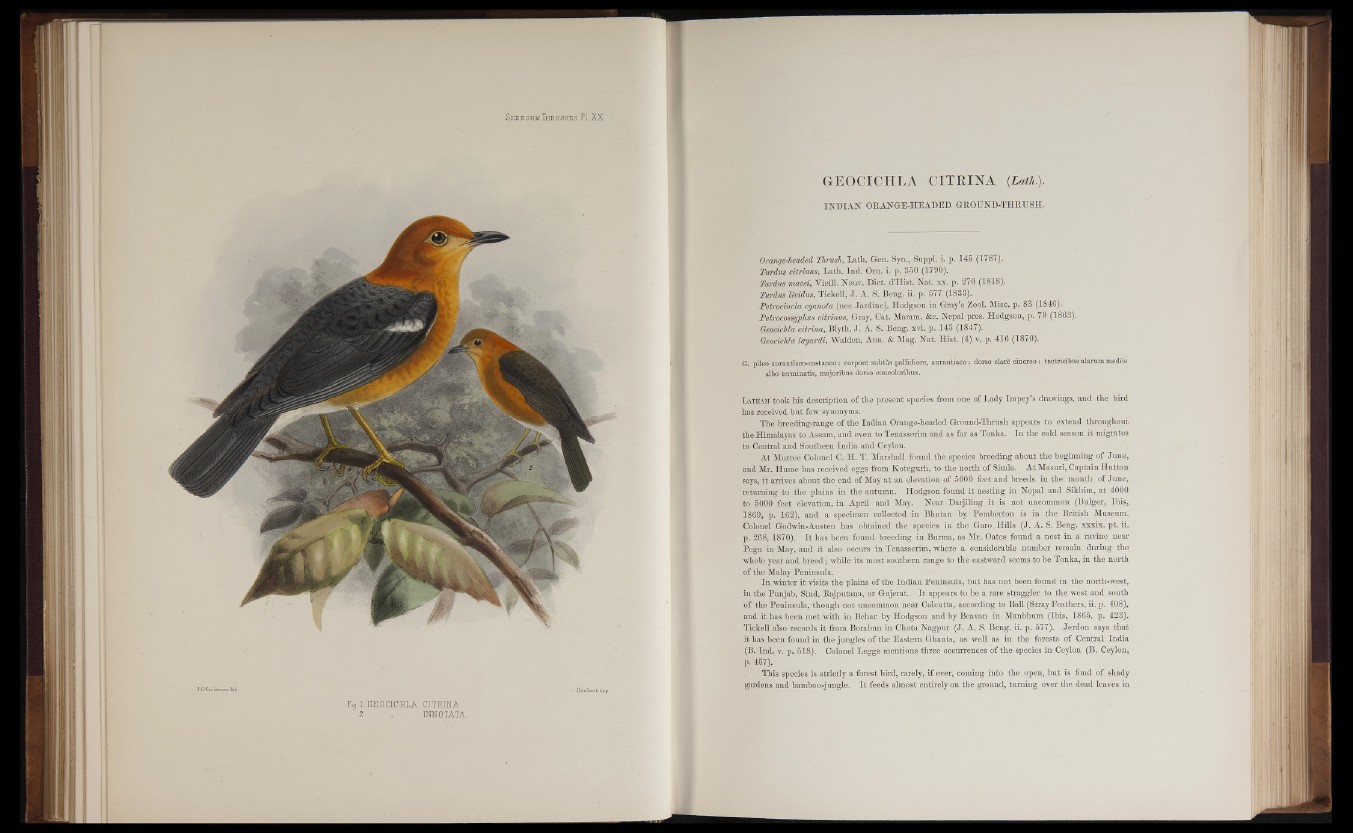
E j.l. GEOCICHLA CITRINA
2 % ‘DINOTATA
IND IA N ORANGE-HEADED GROTJND-THRUSH.
Orange-headed Thrush, Lath. Gen. Syn., Suppl. i. p. 145 (1787).
Turdus citrinus, Lath. Ind. Orn. i. p. 350 (1790).
Turdus macei, Vieill. Nouv. Diet. d’Hist. Nat. xx. p. 270 (1818).
Turdus lividus, Tickell, J. A. S. Beng. ii. p. 577 (1833).
Petrocincla cyanota (nec Jardine), Hodgson in Gray’s Zool. Misc. p. 83 (1846).
Petrocossyphus citrinus, Gray, Cat. Mamm. &c. Nepal pres. Hodgson, p. 79 (1863).
Geocichla citrina, Blyth, J. A. S. Beng. xvi. p. 145 (1847).
Geocichla layardiy'Walden, Ann. & Mag. Nat. Hist. (4) v. p. 416 (1870).
G. pileo auranti aco-castaneo: corpore subtus pallidiore, aurantiaco: dorso clare cinereo : tectricibus alarum mediis
albo terminatis, majoribus dorso concoloribus.
L atham took his description of the present species from one of Lady Impey’s drawings, and the bird
has received but few synonyms.
The breeding-range of the Indian Orange-headed Ground-Thrush appears to extend throughout
the Himalayas to Assam, and even to Tenasserim and as far as Tonka. In the cold season it migrates
to Central and Southern India and Ceylon.
At Murree Colonel C. H. T. Marshall found the species breeding about the beginning of June,
and Mr. Hume has received eggs from Kotegurh, to the north of Simla. At Masuri, Captain Hutton
says, it arrives about the end of May at an elevation of 5000 feet and breeds in the month of June,
returning to the plains in the autumn. Hodgson found it nesting in Nepal and Sikhim, at 4000
to 5000 feet elevation, in April and May. Near Darjiling it is not uncommon (Bulger, Ibis,
1869, p. 162), and a specimen collected in Bhutan by Pemberton is in the British Museum.
Colonel Godwin-Austen has obtained the species in the Garo Hills (J. A. S. Beng. xxxix. pt. ii.
p. 268,1870). It has been found breeding in Burma, as Mr. Oates found a nest in a ravine near
Pegu in May, and it also occurs in Tenasserim, where a considerable number remain during the
whole year and breed; while its most southern range to the eastward seems to be Tonka, in the north
of the Malay Peninsula.
In winter it visits the plains of the Indian Peninsula, but has not been found in the north-west,
in the Punjab, Sind, Rajputana, or Gujerat. It appears to be a rare straggler to the west and south
of the Peninsula, though not uncommon near Calcutta, according to Ball (Stray Feathers, ii. p. 408),
and it has been met with in Behar by Hodgson and by Beavan in Manbhum (Ibis, 1865, p. 423).
Tickell also records it from Borabun in Chota Nagpur (J. A. S. Beng. ii. p. 577). Jerdon says that
it has been found in the jungles of the Eastern Ghauts, as well as in the forests of Central India
(B. Ind. v. p. 518). Colonel Legge mentions three occurrences of the species in Ceylon (B. Ceylon,
p.'457).
This species is strictly a forest bird, rarely, if ever, coming into the open, but is fond of shady
gardens and bamboo-jungle. It feeds almost entirely on the ground, turning over the dead leaves in